|
|
 |
Fiche d'espèce de Copépode |
|
|
Calanoida ( Ordre ) |
|
|
|
Calanoidea ( Superfamille ) |
|
|
|
Megacalanidae ( Famille ) |
|
|
|
Elenacalanus ( Genre ) |
|
|
| |
Elenacalanus tageae Bradford-Grieve, Blanco-Bercial & Boxshall, 2017 (F,M) | |
| | | | | | | Ref.: | | | Bradford-Grieve & al?, 2017 (p.148, Descr. F, M, figs. F, M, phylogeny) | 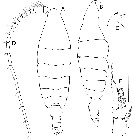 Issued from : J.M. Bradford-Grieve, L. Blanco-Bercial & G.A. Boxshall in Zootaxa, 2017, 4229 (1). [p.149, Fig.101]. Female (from 27.133°N, 138.233°E): A-B, habitus (dorsal and lateral, respectively); C, rostrum (lateral); D, left A1; E, P1 (posterior view). Scale bars: 1.0 mm on all figures. Nota: - Forehead in dorsal view with low projection dorsal to base of rostrum. - In lateral view, posterior corners pf pediger 5 rounded. - Genital double-somite symmetrical in dorsal view, bulbous, about as long as wide; in lateral view bulging both ventrally and dorsally, and is much deeper than following somite. - A1 extending beyond caudal rami by at least 7 segments (segments XXI-XXVIII broken off). Segments I-V each with dorsal surface hair sensillum and adjacent macula cribrosa.
|
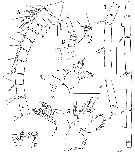 Issued from : J.M. Bradford-Grieve, L. Blanco-Bercial & G.A. Boxshall in Zootaxa, 2017, 4229 (1). [p.150, Fig.102]. Female : A, A1 ancestral segments I-XII (hs = hair sensillum; mc = macula cribrosa); B, A1 ancestral segments XIII-XVI; C, A1 ancestral segments XVII-XX; D, A2; E, Md palp; F, distal part of Md gnathobase; G, Mx1. Scale bars: 1.0 mm (A-E); 0.1 mm on remaining figures. Nota: - A2 exopod ancestral segment IV very short seta not extending beyond segment V. - Mx1 praecoxal arthrite with 13 setae including 2 on posterior surface and 1 longer and 1 smaller seta on anterior surface; coxal endite without setae; basal endites 1 and 2 with 2 setae each; endopod segments with 1, 1, 4+1 small anterior surface seta; basal exite with 1 vestigial seta; epipodite with 7 long and 2 very small setae.
|
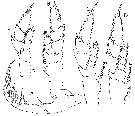 Issued from : J.M. Bradford-Grieve, L. Blanco-Bercial & G.A. Boxshall in Zootaxa, 2017, 4229 (1). [p.151, Fig.103]. Female: A, Mxp; B, P2 (anterior view); C, P3 (anterior view); D, P4 (anterior view); E, P5 (anterior view). Scale bar: 1.0 mm on all figures. Nota: - Mxp syncoxal endite 4 longest seta broken off- probably extending as far as distal basal seta as in male; endopod segments 2-6 with 4 (subequal), 1, 1, 1 (no outer border seta but 1 macula cribrosa), 4 setae (2 large and 2 small, of which 1 on outer border), respectively
|
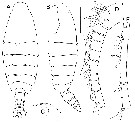 Issued from : J.M. Bradford-Grieve, L. Blanco-Bercial & G.A. Boxshall in Zootaxa, 2017, 4229 (1). [p.152, Fig.104]. Male (from 20.933°N, 138.533°E): A-B, habitus (dorsal and lateral, respectively); C, forehead (lateral); D, right A1 ancestral segmentss I-XII; E, right A1 ancestral segments XIII-XVI. Scale bars: 1.0 mm ( on all figures). Nota: - Forehead similar to that of female. - In lateral view, posterior corners of pediger 5 rounded. - Urosomite II length 0.8 times its width in dorsal view. Urosomite II is 1,5 times as long as urosomite III. - A1 not entire; left A1 absent; right A1 first ancestral segments remaining, ancestral segments IX-XI fused and XIV-XV fused on right.
|
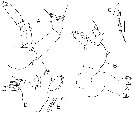 Issued from : J.M. Bradford-Grieve, L. Blanco-Bercial & G.A. Boxshall in Zootaxa, 2017, 4229 (1). [p.153, Fig.105]. Male: A, A2; B, Md; C, dorsal part of Md gnathobase; D, Mx1; E, coxal epipodite of Mx1. Scale bars: 0.1 mm on all figures. Nota: - A2 exopod ancestral segments I-IV without setae. - Md basis with 4 (2 very small) inner setae. - Mx1 setation reduced in number and size relative to female: basal endites 1 and 2 with 2 and 1 reduced seta, respectively; endopod segments with 1 reduced, 1 reduced, 4+1 anterior surface seta; basal exite without seta, epipodite with 7 long setae.
|
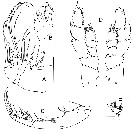 Issued from : J.M. Bradford-Grieve, L. Blanco-Bercial & G.A. Boxshall in Zootaxa, 2017, 4229 (1). [p.154, Fig.106]. Male: A, Mx2; B, endopod of Mx2; C, Mxp; D, P5 (anterior view); E, inner distal corner of left exopod segment 2 of P5. Scale bars: 1.0 mm (A, C, D); 0.1 mm (B, E). Nota:
- Mx2 with longest setae extending only as far as anterior part of labrum.
- Mxp similar to that of female; syncoxal endite 4, longest seta extending to distal basal seta.
- P1-P4 similar to those of female, especially exopodal segment 3 of P1 which has proximal outer spine extending beyond base of distal outer spine.
- P5 slightly asymmetrical, left leg slightly longer than right leg; left exopodal segment 2 inner distal corner bearing bifurcate specialised seta with 2 short setulose lashes arising from proximal part; inner border of exopodal segment 3 naked on right, irregularly shaped and lined with setules on left.
|
 Issued from : J.M. Bradford-Grieve, L. Blanco-Bercial & G.A. Boxshall in Zootaxa, 2017, 4229 (1). [p.91, Table 11]. Morphological characters after identification key of Elenacalanus females and males. Compare to other species of genus. 1 - Head without crest. 2 - Mx1 basal endite 2 with 2 (in female) or 1 setae (reduced in male). 3 - Md basis proximalmost seta placed approximately at midlength of inner border. 4 - Female P1 exopod segment , proximal outer spine extends beyond base of distal outer spine; male P5 left exopod segment 2 specialised seta with 2 equal, short setulose lashes.
| | | | | NZ: | 1 | | |
|
Carte de distribution de Elenacalanus tageae par zones géographiques
|
| | | | Loc: | | | NW Pacif. (SE Japan).
Type locality : 26.441° N, 139.037° E. | | | | N: | 1 | | | | Lg.: | | | (1316) F: 13,4; M: 12,7; {F: 13,4; M: 12,7} | | | | Rem.: | Bathypelagic.
For Bradford-Grieve & al. (2017, p.149) the female resemble E. eltaninae, differing only the longer proximal outer spine on P1 exopodal segment 3 (extends beyond base of distal outer spine in E. tageae but short of this spine in E. eltaninae); also the main difference is the the male P5 left specialised seta on exopodal segment 2: in E. tageae it is bifurcate with each short lash approximately equal in length while in E. eltaninae this seta is composed of a large rounded outer lobe and elongate inner lash. | | | Dernière mise à jour : 19/06/2023 | |
|
|
 Toute utilisation de ce site pour une publication sera mentionnée avec la référence suivante : Toute utilisation de ce site pour une publication sera mentionnée avec la référence suivante :
Razouls C., Desreumaux N., Kouwenberg J. et de Bovée F., 2005-2025. - Biodiversité des Copépodes planctoniques marins (morphologie, répartition géographique et données biologiques). Sorbonne Université, CNRS. Disponible sur http://copepodes.obs-banyuls.fr [Accédé le 24 décembre 2025] © copyright 2005-2025 Sorbonne Université, CNRS
|
|
 |
 |









